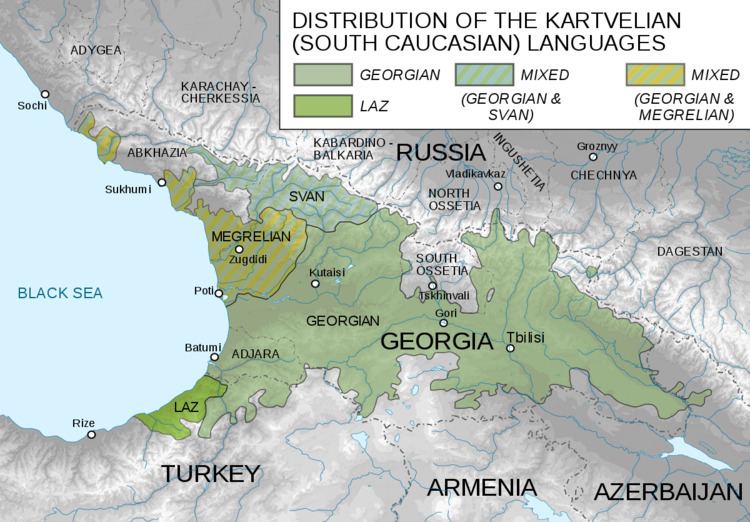ISO 639-5: ccs | Glottolog: kart1248 | |
 | ||
Linguistic classification: One of the world's primary language families | ||
The Kartvelian languages (Georgian: ქართველური ენები) (also known as Iberian and formerly South Caucasian) are a language family indigenous to the Caucasus and spoken primarily in Georgia, with large groups of native speakers in Russia, Iran, the United States, the European Union, Israel, and northeastern parts of Turkey. There are approximately 5.2 million speakers of Kartvelian languages worldwide. It is not known to be related to any other language family, making it one of the world's primary language families. The first literary source in a Kartvelian language is the Georgian language inscriptions of Bir el Qutt, written in ancient Georgian Asomtavruli script at the Georgian monastery near Bethlehem, which dates back to c. 430 AD.
Contents
The Georgian script is the writing system used to write all Kartvelian languages, though the Laz language in Turkey is also written using a Latin script.
Social and cultural status
Georgian is the official language of Georgia (spoken by 90% of the population) and the main language for literary and business use for all Kartvelian speakers in Georgia. It is written with an original and distinctive alphabet, and the oldest surviving literary text dates from the 5th century AD—the only Caucasian language with an ancient literary tradition. The old Georgian script seems to have been derived from Aramaic, with Greek influences.
Mingrelian has been written with the Georgian alphabet since 1864, especially in the period from 1930 to 1938, when the Mingrelians enjoyed some cultural autonomy, and after 1989.
The Laz language was written chiefly between 1927 and 1937, and now again in Turkey, with the Latin alphabet. Laz, however, is disappearing as its speakers are integrating into mainstream Turkish society.
Classification
The Kartvelian language family consists of four closely related languages:
The connection between these languages was first reported in linguistic literature by Johann Anton Güldenstädt in his 1773 classification of the languages of the Caucasus, and later proven by G. Rosen, Marie-Félicité Brosset, Franz Bopp and others during the 1840s. Zan is the branch that contains the Mingrelian and Laz languages.
On the basis of glottochronological analysis, Georgi Klimov dates the split of the Proto-Kartvelian into Svan and Proto-Karto-Zan to the 19th century BC, and the further division into Georgian and Zan to the 8th century BC, although with the reservation that such dating is very preliminary and substantial further study is required.
The older name "South Caucasian" is no longer much used, as it derives from the idea that Kartvelian is related to the Northwest Caucasian and Northeast Caucasian languages, a position which is no longer maintained.
Higher-level connections
No relationship with other languages, including the two North Caucasian language families, has been demonstrated so far. Some linguists, such as Tamaz V. Gamkrelidze have proposed that the Kartvelian family is part of a much larger Nostratic language family, but both the concept of a Nostratic family and Georgian's relation to it are not considered likely by linguists.
Certain grammatical similarities with Basque, especially in the case system, have often been pointed out. However, this hypothesis, which also tend to link the Caucasian languages with other non-Indo-European and non-Semitic languages of the Near East of ancient times, are generally considered to lack conclusive evidence. Any similarities to other linguistic phyla may be due to areal influences. Heavy borrowing in both directions (i.e. from North Caucasian to Kartvelian and vice versa) has been observed; therefore it is likely that certain grammatical features have been influenced as well. If the Dené–Caucasian hypothesis, which attempts to link Basque, Burushaski, the North Caucasian families and other phyla, is correct, then the similarities to Basque may also be due to these influences, however indirect. Certain Kartvelian-Indo-European lexical links are revealed at the protolanguage level, which are ascribed to the early contacts between Proto-Kartvelian and Proto-Indo-European populations.
Noun classification
The Kartvelian languages classify objects as intelligent ("who"-class) and unintelligent ("what"-class) beings. Grammatical gender does not exist.
Verb
Kartvelian verbs can indicate one, two, or three grammatical persons. A performer of an action is called the subject and affected persons are objects (direct or indirect). The person may be singular or plural. According to the number of persons, the verbs are classified as unipersonal, bipersonal or tripersonal.
Subjects and objects are indicated with special affixes.
By means of special markers Kartvelian verbs can indicate four kinds of action intentionality ("version"):
